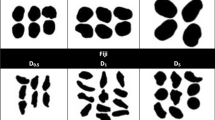Abstract
Thermogravimetry and differential thermal analysis have been applied to the study of peats from the main Spanish basements.
The results obtained show that the degree of transformation of the organic matter increases as the depth of the peat increases.
The intensity of the weight loss corresponding to the first exothermic effect (directly related to the carbohydrate content of the sample, and inversely related to the content of humic compounds) is, in the case of the peats with a high degree of transformation, strongly influenced by the nature of their humic acids.
On the other hand, the displacement of this exothermic effect towards lower temperatures is directly related to the ash content of the samples.
Zusammenfassung
Die thermogravimetrische Analyse und die Differentialthermoanalyse wurden zum Studium von Torfen aus den wichtigsten spanischen Lagerstätten eingesetzt.
Die erhaltenen Ergebnisse zeigen, daß der Umwandlungsgrad der organischen Substanz mit zunehmender Tiefe des Torfes zunimmt.
Die Intensität des dem ersten exothermen Effekt entsprechenden Gewichtsverlustes (welcher dem Kohlenhydratgehalt der Probe direkt und seinem Huminverbindungsgehalt umgekehrt proportional ist) wird im Falle von Torfen von hohem Umwandlungsgrad durch die Beschaffenheit ihrer Huminsäuren stark beeinflußt.
Andererseits ist die Verschiebung dieses exothermen Effekts in Richtung der niedrigeren Temperaturen dem Aschegehalt der Proben direkt proportional.
Резюме
Термогравиметричес кий и дифференциальн ый термический анализ б ыл использован для изучения торфов в главных испанских по двалах. Полученные результа ты показали, что степень превраще ния органического ве щества увеличивается по мер е увеличен глубины торфа. Степен ь потери веса на перво м экзотермическом пик е (прямо связанного с содержанием углевод ов и в обратной степен и с содержанием гуминов ых соединений в образ це) в случае торфов с высо кой степенью превращ ения, сильно зависит от природы их гуминовых кислот. С др угой стороны, сывиг эт ого экзотермического пи ка к более низким температурам находи тся в прямой зависимо сти от содержания золы.
Similar content being viewed by others
References
I.Hoffman and M.Schnitzer, Thermal analysis '65 Proc. 1st Int. Congr. Aberdeen, 1965, Ed. J. P. Redfern.
J. M. Stewart, A. C. Birnie andB. D. Mitchell, Agrochimica, 11 (1966) 92.
T. Dupuis, P. Jambu andJ. Dupuis, Ann. Agron., 21 (1979) 75.
M. Levesque andH. Dinel, Geoderma, 20 (1979) 201.
R. C. Turner andM. Schnitzer, Soil Sci., 93 (1962) 225.
Author information
Authors and Affiliations
Rights and permissions
About this article
Cite this article
Almendros, G., Polo, A. & Vizcayno, C. Application of thermal analysis to the study of several Spanish peats. Journal of Thermal Analysis 24, 175–182 (1982). https://doi.org/10.1007/BF01913671
Received:
Issue Date:
DOI: https://doi.org/10.1007/BF01913671




